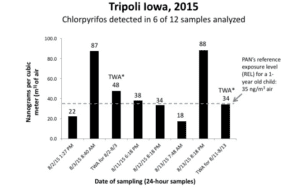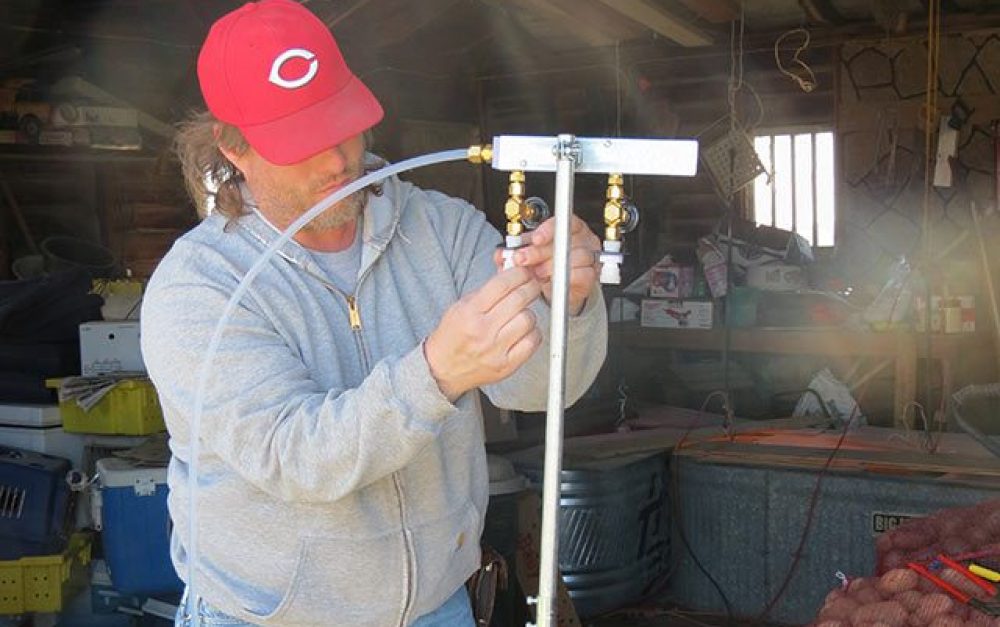It has been over a decade since the moment I felt the droplets of pesticides on my head and shoulders as a crop duster flew over our farm in Iowa. To be precise, it has been 11 years, 3 months and 18 days since a mix of chlorpyrifos and two other pesticides was dumped on the western portion of our farm, coating our vegetable crops, our poultry, our bees, and our person, with an unwanted cocktail of poisons. If you cannot tell by this introduction, that moment was a pivotal point for my farm and my life.
So, I was among those who were glad to hear that EPA effectively banned chlorpyrifos on food and feed crops in 2021, by setting tolerance levels of that pesticide on food to zero. While it did not solve the problems of drift and pesticide misapplication I have experienced, I knew this step was an important one. And now, I am among those who are equally dismayed by a recent court ruling that reversed EPA’s action to limit use of this dangerous insecticide.
Chlorpyrifos injury starts the journey
After I was coated with pesticides during the 2012 incident at our farm, I was left with the question, “Now what do I do?” After a quick call to a trusted doctor, I ended up taking a shower for the next half hour. But the damage was done. I ended up having to seek treatment for breathing problems and I found that I sunburned much more easily during the weeks that followed.
That was my first truly meaningful introduction to chlorpyrifos – an acute pesticide poisoning caused by an aerial applicator that wasn’t terribly concerned about where they dropped the chemical. Prior to that, it was just another pesticide that row crop farmers used on their crops every year. I didn’t like it, but I lived in Iowa and that’s how it was. I was just like other members in a rural community – we just dealt with it.
I also farmed, but I had opted not to use any form of chemical pesticide, preferring to use crop rotation, intercropping and wild spaces to deal with pests and diseases. So, while I was aware that other farmers used them, I didn’t really concern myself too much with the details of particular chemicals or formulations. I was more concerned that their applications of pesticides stay on their side of the fence.
But after experiencing this misapplication, I became invested in learning about chlorpyrifos and other pesticides. And, what I was learning moved me from having a general concern that pesticides were a philosophical problem to a growing realization that they posed a great danger to us all.
Chlorpyrifos drifts easily
A few years later, in 2015, our farm participated in PAN’s Drift Catcher, a citizen-science project. As a participant, we were given a compressor that would pull air through test tubes with resins that would collect certain insecticides, chlorpyrifos among them, if they were there.
I diligently changed the test tubes twice a day during spray season. I labeled each carefully and placed them in a freezer until all of the samples were collected and could be sent in for testing. I wrote down observations about the weather and took notes about who in the area was spraying.
When the results came back, we learned that we had “positive results” for chlorpyrifos. And this was certainly one of those times where “positive” did not mean “good.” Neither of these readings were taken at a time when one of the fields adjacent to our farm was applying pesticides. Instead, both readings came at a time when the target field was at least a half-mile away.
It was at this moment I learned something else. Chlorpyrifos drifts from its target application easily and well. Particle drift of pesticides occurs during the spray, or application, process. Smaller particles of the pesticide can be carried by the wind to locations outside of the intended spray zone. Some pesticides are more prone to drift than others, and chlropyrifos is among those that drift easily.

TWA – Time Weighted Average; REL – Reference Exposure Level
As I reviewed our test results, I was astonished to learn that one set of positive readings was the result of an application that was over a half-mile away and, while the wind was coming our way, the wind speed did not exceed five miles an hour.
I started to ask myself how much exposure people like Tammy, my partner, and I have had to chlorpyrifos over the years? How much did we inadvertently allow our farmworkers, often college or high school students – somebody’s children – to be exposed to these chemicals? And what about the neighbors’ children? Clearly chlorpyrifos travels through the air and is finding its way into our bodies. And we knew its use was, and still is, ubiquitous in our state.
EPA needs to affirm and complete the chlorpyrifos ban
I realize that it is often difficult for people to fully appreciate and understand the dangers chlorpyrifos poses to those who are regularly exposed to it – until they or someone they care for experiences it for themselves. I am ashamed to admit that I was among those people. But now I have had some of my own experiences and I believe it is important to share them with you – hoping you will understand without going through this process of discovery by exposure.
This is why it is important for the EPA to re-establish the chlorpyrifos ban on food and feed products. But, that, by itself, isn’t the whole story. The food ban does not impact corn crops for ethanol, or row crops used for seed production. It does not remove its availability for ornamental plants or roadside applications. This is why I believe the EPA should go further and simply ban its use entirely.
It’s for the good of farmworkers who spend their days outdoors and in harm’s way. It’s for the children in communities who play next door to fields that receive regular applications of this chemical. It’s for you and me, because we don’t need persistent doses of this dangerous pesticide in our lives any longer.








